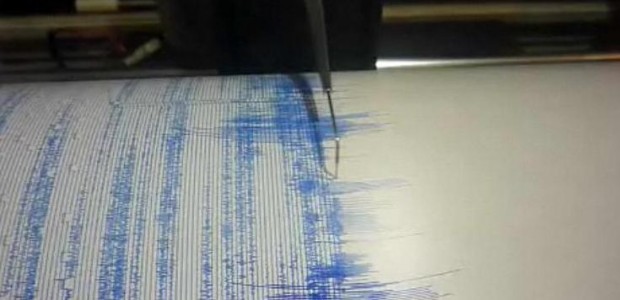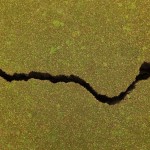Oil And Gas Related Earthquakes? Texas Regulators Speak no Evil

Still image taken from video posted to Flikr Creative Commons by Waifer X. http://www.flickr.com/photos/waiferx/2658307394/
A seismograph measures feet stomping nearby at the Thomas A. Jaggar Museum, Hawaiian Volcano Observatory, Hawaii Volcanoes National Park, HI.
StateImpact Texas’ Terrence Henry contributed reporting to this article.
Close to midnight last September 29th, the Tarrant County 9-1-1 call center lit up with phone calls from outside its usual service area. The ground was shaking again, and people in nearby Irving, Texas had overwhelmed their own 9-1-1 system.
“What’s going on are we having tremors?” one woman asked.
On the call, obtained by StateImpact Texas in an open records request, a child is heard yelling in the background.
“It was an earthquake, Yes ma’am. Apparently [Irving’s 911] phones are being inundated with calls and they’re overflowing into our police department,” said the operator.
A review of the calls shows people who were were scared, unsure whether to go back to their houses and, at times, annoyed by the lack of information from responders. In one tape, a caller chuckles at an operator’s suggestion that she can re-enter her house “if the building doesn’t seem to be falling down or unstable.”
Earthquakes were not a part of life in the Dallas-Fort Worth area until recently. Now, they are. There have been more than 50 of them since 2008. The people there are getting a crash course in seismic rumbling.

Doyle Willis Jr.
Libby Willis, former president of the Forth Worth League of Neighborhood Associations.
“You know it always starts as kind of curiosity,” Libby Willis, former president of the Fort Worth League of Neighborhood Associations told StateImpact Texas. “And then as it continues, it becomes maybe kind of a nuisance and then it progresses into: ‘Well. Do we have an issue here? And what are we going to do to deal with it?'”
Willis serves on the Gas Drilling Committee for her neighborhood group. She became involved in the local discussion over earthquakes when the Fort Worth City Council was debating whether to permanently ban oil and gas drilling disposal wells within the city limits.
Those wells have a lot to do with the uptick in earthquakes, says Cliff Frohlich, a research scientist at the Institute for Geophysics at the University of Texas at Austin. From his office at UT’s J.J. Pickle Research Center, Frohlich recently told the story of how he received calls from reporters asking if the quakes were related to oil and gas when they began in 2008.
“I said, ‘no they don’t have anything to do with oil and gas,'” he remembered. “This is probably the most misinformed statement I’ve ever made publicly.”
“All this stuff had happened and a seismologist like me didn’t know about it,” Frohlich added.
The “stuff” he was talking about is the gas drilling boom that had rolled into North Texas.
How it Works
If he had known about the new rush to drill in the Barnett Shale around Dallas-Fort Worth, Frohlich says, the cause of those quakes would have been clearer. Here’s what happens: Liquid used in oil and gas drilling needs to be stored somewhere after it’s used. So companies drill disposal wells, and they inject that liquid byproduct back into the ground. It’s some of those disposal wells that can cause earthquakes.

Photo by Mose Buchele
Cliff Frohlich studies earthquakes from his office at UT's J.J. Pickle Research Campus.
“The model I use is called the air hockey table model,” says Frohlich. “You have an air hockey table, suppose you tilt it, if there’s no air on, the puck will just sit there. Gravity wants it to move but it doesn’t because there friction [with the table surface].”
But if you turn the air on for the air hockey table, the puck slips.
“Faults are the same,” he says. If you pump water in a fault, the fault can slip, causing an earthquake.
“Scientists in my community know that injection can sometimes cause earthquakes,” Frohlich says.
Decades ago, researchers even found they could turn earthquakes on and off by injecting liquid into the ground, says Dr. William Ellsworth with the Earthquake Science Center of the U.S. Geological Survey.
“This was seen as validation of the effective stress model,” he told StateImpact Texas. “This is work that was published in Science magazine and many other publications.”
But there are still places where people express skepticism over the relationship between disposal wells and earthquakes. And the state agency that regulates injection wells in Texas is one of them.
Wait and See
In a recent public forum hosted by the Texas Tribune, Railroad Commission Chair Barry Smitherman said he was aware of what he called “allegations” of a link.
“I know there are a number of studies being done and I think the University of Texas is doing one, and I’m anxious to see what kind of results we’re going to get,” he said in response to a question from StateImpact Texas.
To figure out how seriously the Commission was taking man-made earthquakes, StateImpact Texas filed open records requests for Commission emails relating to the subject.
The 111 pages of emails the Commission supplied show that staff members there accept what scientists and oilmen have known for decades: Injection wells can cause earthquakes. They even show staff members in communication with EPA researchers over certain quakes. The messages include forwards of media reporting on earthquakes and notes of concern from Texans.
Then the emails stop.
The last email about earthquakes that the Railroad Commission has on record was dated August 6, 2012. There was no record of electronic communication about the quakes that hit the Dallas area in late September, nor about quakes that hit North Texas in October, November or December.
The Railroad Commission is starting the process of writing new rules about disposal wells. But in an email to StateImpact Texas, the Commission said those proposed amendments “do not address seismic activity.”
That’s disappointing to some who live within Texas’ newly earthquake-prone regions.
The Options on the Table
“I don’t think [the Railroad Commission regulators] have the lead in this area,” says Libby Willis from the Fort Worth League of Neighborhoods Associations.
“You know earthquakes catch the public’s attention, and there’s always a desire to not acknowledge the things that may not be so attractive about disposal wells or anything associated with the fracking and the drilling,” she adds.
Other places have created regulation for earthquake risk. Last year, regulators in Ohio instituted laws limiting the depth wells could be drilled, and mandating that drillers do geological tests, and monitor the liquid volume and pressure in disposal wells. The year before that, the state of Arkansas declared a moratorium on wells, citing earthquakes as a concern. Here in Texas, the Fort Worth City Council went on to pass the ban on new disposal wells in its city limits.
Researcher Cliff Frohlich doesn’t agree with some of the new policies, worrying that a rush to rule making could create new regulations that are too “draconian.” But he says there are things drillers could do if they were concerned about a disposal well.
“For example, if a well is causing earthquakes you could take the fluids to a different well,” he said. “If the fluids are causing earthquakes you could treat them, the way you do sewage and put it back in the creek.”
Other researchers, like Dr. Ellsworth, say it would simply be beneficial to have more data to study. That could mean greater monitoring of water volume and pressure in disposal wells.
Frohlich says regulation may also look different in large population centers, where earthquakes pose the greatest risk to life and property. Not surprisingly, those are the same places where concern is rising that regulators aren’t doing enough about the shaking underground.
So far, seismic events in Texas have been mostly small ones. But earthquakes that were likely man-made have been larger in other parts of the world. Even a medium size quake would be a financial disaster if it struck in the heart of Dallas-Fort Worth.


